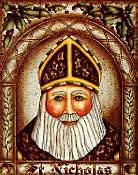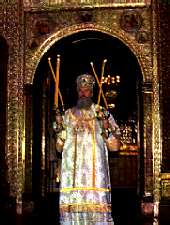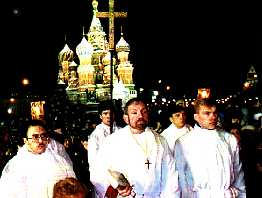CHRISTMAS
in
RUSSIA
|
 St. Nicholas is especially popular in Russia. The legend is that the 11th-century Prince Vladimir traveled to Constantinople to be baptized, and returned with stories of miracles performed by St. Nicholas of Myra. Since then many Eastern Orthodox Churches have been named for the saint, and to this day, Nicholas is one of the most common names for Russian boys. The feast of St. Nicholas (December 6) was observed for many centuries, but after the communist revolution, the celebration of the feast was suppressed, only to return after the fall of Communism. St. Nicholas is especially popular in Russia. The legend is that the 11th-century Prince Vladimir traveled to Constantinople to be baptized, and returned with stories of miracles performed by St. Nicholas of Myra. Since then many Eastern Orthodox Churches have been named for the saint, and to this day, Nicholas is one of the most common names for Russian boys. The feast of St. Nicholas (December 6) was observed for many centuries, but after the communist revolution, the celebration of the feast was suppressed, only to return after the fall of Communism.
Many other religious and folk traditions were suppressed during the communist era. Before the revolution, a figure called Babouschka would bring gifts for the children. Like Italy's La Befana, the story is that Babouschka failed to give food and shelter to the three wise men during their journey to visit the Christ Child. According to tradition, she still roams the countryside searching for the Christ Child and visiting the homes of children during the Christmas season. Babouschka never completely disappeared, and now in the post-communist era, has returned openly. Christmas trees were also banned by the Communist regime and were replaced by "New Year's" trees.
 Most Christian Russians belong to the Eastern Orthodox Church, and it is customary to fast until after the first church service on January 6, Christmas Eve. The church in Russia still uses the old Julian calendar, therefore their Christmas celebration is 13 days behind the Gregorian calendar that we use.
Most Christian Russians belong to the Eastern Orthodox Church, and it is customary to fast until after the first church service on January 6, Christmas Eve. The church in Russia still uses the old Julian calendar, therefore their Christmas celebration is 13 days behind the Gregorian calendar that we use.
Christmas Eve dinner is meatless but festive. The most important ingredient is a special porridge called kutya. It is made of wheatberries or other grains which symbolize hope and immortality, and honey and poppy seeds which ensure happiness, success, and untroubled rest. A ceremony involving the blessing of the home is frequently observed. The kutya is eaten from a common dish to symbolize unity. Some families used to throw a spoonful of kutya up to the ceiling. According to tradition, if the kutya stuck, there would be a plentiful honey harvest.
 For many Russians, a return to religion represents a return to their old roots and their old culture. Throughout Russia, after Christmas Eve services, people carrying candles, torches, and homemade lanterns parade around the church, just as their grandparents and great-grandparents did long ago. The Krestny Khod procession is led by the highest-ranking member of the Russian Orthodox Church. After the procession completes its circle around the church, the congregation reenters and they sing several carols and hymns before going home for a late Christmas Eve dinner. For many Russians, a return to religion represents a return to their old roots and their old culture. Throughout Russia, after Christmas Eve services, people carrying candles, torches, and homemade lanterns parade around the church, just as their grandparents and great-grandparents did long ago. The Krestny Khod procession is led by the highest-ranking member of the Russian Orthodox Church. After the procession completes its circle around the church, the congregation reenters and they sing several carols and hymns before going home for a late Christmas Eve dinner.

© 1999-2001 by W. C. Egan
|
